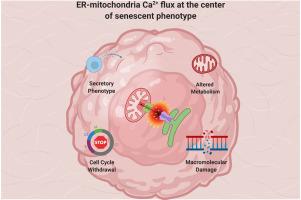Biochimica et Biophysica Acta (BBA) - Molecular Cell Research ( IF 4.6 ) Pub Date : 2021-07-16 , DOI: 10.1016/j.bbamcr.2021.119099 Ulises Ahumada-Castro 1 , Andrea Puebla-Huerta 1 , Victor Cuevas-Espinoza 1 , Alenka Lovy 2 , J Cesar Cardenas 3

|
Cellular senescence generates a permanent cell cycle arrest, characterized by apoptosis resistance and a pro-inflammatory senescence-associated secretory phenotype (SASP). Physiologically, senescent cells promote tissue remodeling during development and after injury. However, when accumulated over a certain threshold as happens during aging or after cellular stress, senescent cells contribute to the functional decline of tissues, participating in the generation of several diseases. Cellular senescence is accompanied by increased mitochondrial metabolism. How mitochondrial function is regulated and what role it plays in senescent cell homeostasis is poorly understood. Mitochondria are functionally and physically coupled to the endoplasmic reticulum (ER), the major calcium (Ca2+) storage organelle in mammalian cells, through special domains known as mitochondria-ER contacts (MERCs). In this domain, the release of Ca2+ from the ER is mainly regulated by inositol 1,4,5-trisphosphate receptors (IP3Rs), a family of three Ca2+ release channels activated by a ligand (IP3). IP3R-mediated Ca2+ release is transferred to mitochondria through the mitochondrial Ca2+ uniporter (MCU), where it modulates the activity of several enzymes and transporters impacting its bioenergetic and biosynthetic function. Here, we review the possible connection between ER to mitochondria Ca2+ transfer and senescence.
Understanding the pathways that contribute to senescence is essential to reveal new therapeutic targets that allow either delaying senescent cell accumulation or reduce senescent cell burden to alleviate multiple diseases.
中文翻译:

让僵尸活着:细胞衰老中的 ER-线粒体 Ca2+ 转移
细胞衰老产生永久性细胞周期停滞,其特征是细胞凋亡抗性和促炎衰老相关分泌表型 (SASP)。在生理上,衰老细胞在发育过程中和损伤后促进组织重塑。然而,当衰老过程中或细胞应激后积累超过一定阈值时,衰老细胞会导致组织功能下降,参与多种疾病的产生。细胞衰老伴随着线粒体代谢的增加。线粒体功能是如何被调节的,以及它在衰老细胞稳态中的作用是什么,我们知之甚少。线粒体在功能上和物理上与内质网 (ER)、主要钙 (Ca 2+) 哺乳动物细胞中的储存细胞器,通过称为线粒体-ER 接触 (MERC) 的特殊域。在该域中,从 ER 中释放 Ca 2+主要受肌醇 1,4,5-三磷酸受体 (IP3R) 的调节,IP3R 是由配体 (IP3) 激活的三个 Ca 2+释放通道家族。IP3R 介导的 Ca 2+释放通过线粒体 Ca 2+单向转运体 (MCU)转移到线粒体,在那里它调节影响其生物能和生物合成功能的几种酶和转运蛋白的活性。在这里,我们回顾了 ER 与线粒体 Ca 2+转移和衰老之间的可能联系。
了解导致衰老的途径对于揭示新的治疗靶点至关重要,这些靶点可以延迟衰老细胞的积累或减少衰老细胞的负担以缓解多种疾病。











































 京公网安备 11010802027423号
京公网安备 11010802027423号